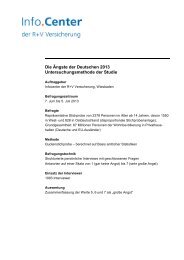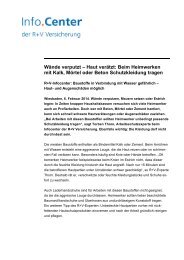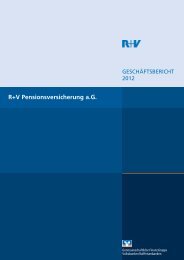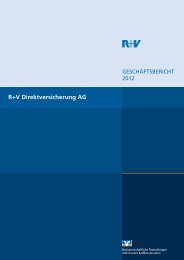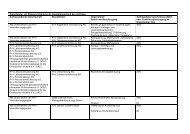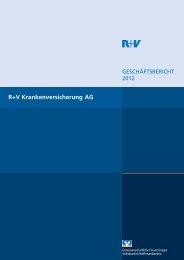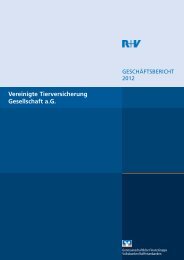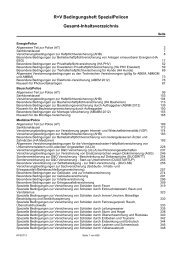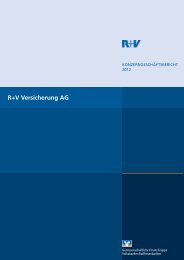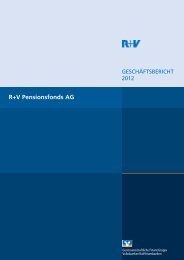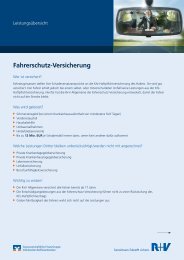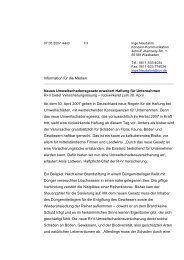R+V Versicherung AG Annual Report
R+V Versicherung AG Annual Report
R+V Versicherung AG Annual Report
You also want an ePaper? Increase the reach of your titles
YUMPU automatically turns print PDFs into web optimized ePapers that Google loves.
Notes<br />
Accounting policies<br />
Basis of preparation<br />
The annual financial statements of <strong>R+V</strong><br />
<strong>Versicherung</strong> <strong>AG</strong> for 2002 were prepared in<br />
accordance with the provisions of the Handelsgesetzbuch<br />
(HGB – German Commercial<br />
Code), the Aktiengesetz (AktG –<br />
German Public Companies Act) and the<br />
provisions of the <strong>Versicherung</strong>saufsichtsgesetz<br />
(V<strong>AG</strong> – German Act on Private<br />
Insurance Undertakings) as well as the<br />
Verordnung über Rechnungslegung von<br />
<strong>Versicherung</strong>sunternehmen (RechVersV –<br />
German Federal Regulations on Insurance<br />
Accounting) of November 8, 1994.<br />
Use of simplification procedure<br />
The annual financial statements for 2002<br />
also cover all business assumed by <strong>R+V</strong><br />
Group companies in 2002, domestic and<br />
foreign third-party life insurance business<br />
and the business of our branch office in<br />
Singapore.<br />
As other non-life business underwritten on<br />
the international reinsurance market is often<br />
settled with the transferring parties long<br />
after the balance sheet date, the provision<br />
laid down in section 27 (1) in conjunction<br />
with section 3 of the RechVersV on approximation<br />
and simplification procedures has<br />
been applied. In line with this, business with<br />
a gross premium volume of €387.7 million<br />
or a 40.5% share of total premiums written<br />
was included one year in arrears. Technical<br />
provisions were increased sufficiently to<br />
meet current and future obligations.<br />
Intangible assets were valued at cost and<br />
written down over their estimated useful<br />
life. Additions in the fiscal year were generally<br />
written down pro rata.<br />
Land, land rights and buildings including<br />
buildings on third-party land were recorded<br />
at acquisition or manufacturing cost less<br />
write-downs. Straight-line depreciation was<br />
performed using the rate allowed by tax<br />
law.<br />
41<br />
Shares in affiliated companies and<br />
associates and other investments were<br />
recorded at cost. Investments held in<br />
foreign currencies were translated using<br />
the exchange rate applicable at the time of<br />
acquisition.<br />
Investments in associates were valued<br />
according to the length of time they have<br />
been held by the Company, as were other<br />
variable-yield securities, bearer bonds<br />
and other fixed-income securities, other<br />
loans and deposits with banks.<br />
Shares, investment certificates and other<br />
variable-yield securities, bearer bonds<br />
and other fixed-income securities were<br />
reported in line with the strict principle of<br />
the lower of cost or market. Write-ups were<br />
made in accordance with section 280 (1)<br />
HGB. These items also include derivative<br />
financial instruments; these were combined<br />
with existing securities in the portfolio to<br />
form microhedges for hedge accounting<br />
purposes.<br />
The equities component for the mixed<br />
funds assigned to the fixed assets in line<br />
with section 341b HGB was valued at the<br />
average rate for the year plus 10%. The<br />
fixed-income component was carried at<br />
the principal amount; derivative hedges<br />
were included at their hedge rate.<br />
The acquisition costs in euros of securities<br />
held in foreign currencies were calculated<br />
using the price of the security and the<br />
exchange rate as of the time of acquisition;<br />
the market value in euros was calculated on<br />
the basis of the price of the security and<br />
the exchange rate as of the balance sheet<br />
date.<br />
Other loans and deposits with banks<br />
were reported at their repayment value,<br />
insofar as specific valuation allowances did<br />
not have to be performed. Deposits with<br />
banks in foreign currencies were translated<br />
using the exchange rate as of the balance<br />
sheet date.



